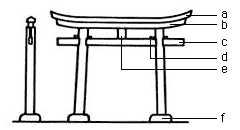|
||
 |
||

(C)2001 Japanese Architecture and Art Net Users System. No reproduction or republication without written permission.
掲載のテキスト・写真・イラストなど、全てのコンテンツの無断複製・転載を禁じます。
|
||||||
| myoujin torii 明神鳥居 | ||||||
| KEY WORD : architecture / shrines | ||||||
| A pillared gate-like entrance to a Shinto shrine, developed around the 9c. The most common type of shrine entrance *torii 鳥居. The myoujin torii is identified by the upward curving ends of the top lintel *kasagi 笠木, and the secondary lintel *shimaki 島木, connected to it. The ends of these two lintels are cut with an inward slant. Below them is a straight, rectangular tie beam *nuki 貫, extending beyond the pillars about 1/5 of its length. The distance from the ground to the underside of the tie beam usually equals the space between the inner sides of the bottom of the pillars. The pillars have an inward incline *uchikorobi 内転. On the upper side of the tie beam, where it is inserted into the pillar, wedges are pounded in on both sides. Either a simple strut *tsuka 束, or a strut covered with a framed inscribed panel, gakuzuka 額束, is attached at the center between the secondary lintel and the tie beam. The pillars generally have mound-shaped or square stone bases *kamebara 亀腹 and shikaku kiso 四角基礎. See *kiso 基礎. Myoujin torii are made of stone ishidorii 石鳥居, or wood, often painted vermilion and black, or nowadays, concrete. Examples include the stone myoujin torii at Hachiman Jinja 八幡神社 (mid-12c) Yamagata prefecture; Hakozaki Jinja 筥崎神社 (1609) Fukuoka prefecture, and Yasaka Jinja 八坂神社 (1646) Kyoto. | ||||||

|
||||||
| REFERENCES: | ||||||
| EXTERNAL LINKS: | ||||||
| NOTES: | ||||||
(C)2001 Japanese Architecture and Art Net Users System. No reproduction or republication without written permission. 掲載のテキスト・写真・イラストなど、全てのコンテンツの無断複製・転載を禁じます。 |
||||||